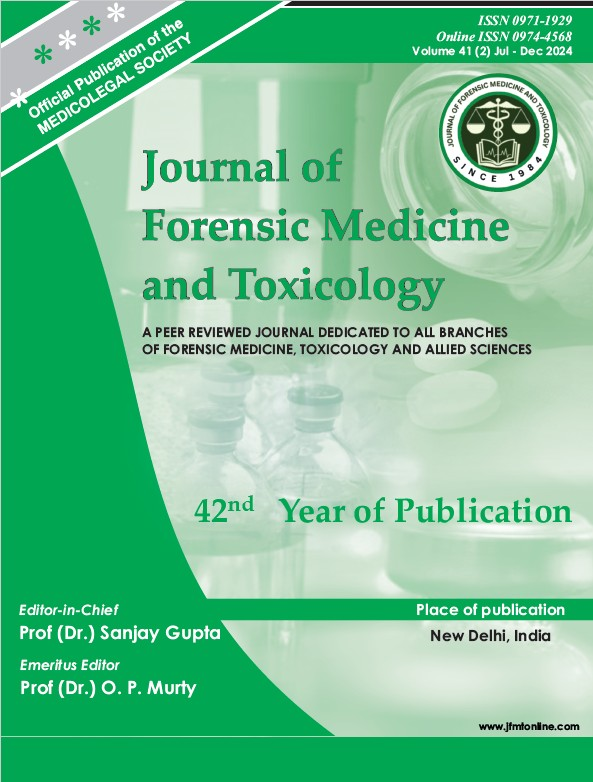DETERMINATION AND CATEGORIZATION OF THE VARIATIONS IN THE PALATAL RUGAE BETWEEN INDIAN AND NEGROID POPULATION
DOI:
https://doi.org/10.48165/jfmt.2024.41.2.23Keywords:
Rugae patterns, Forensic Identification, Palatal rugae, Orthodontics, Palatoscopy, Forensic dentistryAbstract
Palatal rugoscopy is the examination of the palatal rugae. Most people agree that a person’s rugae pattern doesn’t vary over their lifespan. The rugae pattern can endure injury or burns better than most other anatomical structures because of their interior placement in the head. Rugae patterns are also used for personal identification because they are thought to be distinctive like fingerprints. The purpose of this study was to identify and compare the palatal rugae of North Indians and Negroids in terms of quantity, size, and morphology. The study consists of two groups between North Indians and Negroids. 40 plaster casts, aged between 18 and 25, evenly distributed between two groups and genders make up the sample. Alginate impression material was used to create a plaster cast after obtaining an impression of the maxillary arch. Using a sharp graphite pencil and sufficient lighting and magnification, the rugae were identified on the cast and classified in accordance with Thomas and Kotze (1983) and Kapali et al. (1983). Total rugae count was lesser in Indian subjects as compared to the Negroid subjects. The mean rugae count on the left side of the Indian subjects (5.90 ± 1.48) was significantly lesser (p=0.016) than Negroid subjects (7.30 ± 2.00). Rugae size did not differ among Indian and Negroid subjects. The shapes of the rugae varied greatly between the two groups (p=0.003) with the most prominent rugae shape in the Indian population being the curved shape (49.20%) and the most prominent rugae shape in the Negroid population being the straight shape (37%). Given the limits of the current study, it is possible to draw the conclusion that another technique of identifying North Indian and Negroid is the rugae pattern.
Downloads
References
Kavitha, B., Einstein, A., Sivapathasundharam, B. and Saraswathi, T. Limitations in forensic odontology. J Forensic Dent Sci. 2009; 08-10.
Sherif, A.F., Hashim, A.A., Al Hanafy, M.A. and Soliman, E.M. A pilot-cross sectional study of palatal rugae shape and direction among Egyptians and Malaysians. Egypt J Forensic Sci. 2018; 1-9.
BUCHTOVA, M. The development of palatal rugae in the European pine vole, Microtus subterraneus (Arvicolidae, Rodentia). Folia Zoo, 2003. 127-136.
Paliwal A, Wanjari S, Parwani R (2010) Palatal rugoscopy: establishing identity. J Forensic Dent Sci 2(1):27–31
Kapali, S., Townsend, G., Richards, L. and Parish, T. Palatal rugae patterns in Australian Aborigines and Caucasians. Australian Dent J. 1997; 129-133.
Lysell L. Plicae palatinae transversae and papilla incisiva in man:a morphologic and genetic study. Acta Odont Scand1955. 1-137.
Thomas CJ, Kotze TJvW. The palatal rugae pattern: a newclassification. J Dent Assoc South Afr 1983. 153-7.
English, W.R., Robison, S.F., Summitt, J.B., Oesterle, L.J., Brannon, R.B. and Morlang, W.M. Individuality
of human palatal rugae. J Forensic Dent Sci. 1988; 718- 726.
Almeida, M.A., Phillips, C., Kula, K. and Tulloch, C. Stability of the palatal rugae as landmarks for analysis of dental casts. The Angle Orthodontist 1995; 43-48.
Caldas IM, Magalhaes T, Afonso A Establishing identity using cheiloscopy and palatoscopy. Forensic Sci. 2007; 1–9
Thomas CJ, Kotze TJ The palatal rugae pattern: a new classification. J Dent Assoc S Afr . 1983; 153–157 Quoted from
Bharath ST, Kumar GR, Dhanapal R, Saraswathi TR. Sex determination by discriminant function analysis of palatal rugae from a population of coastal Andhra. J Forensic Dent Sci. 2011; 58–60
Sekhar, S.M., Vyas, N., Unnikrishnan, M.K., Rodrigues, G.S. and Mukhopadhyay, C. Correlation of palatal rugoscopy with gender, palatal vault height and ABO blood groups in three different Indian populations. Annals of Medical and Health Sciences Research. 2014; 769-774.
Bharath, S.T., Kumar, G.R., Dhanapal, R. and Saraswathi, T.R. Sex determination by discriminant function analysis of palatal rugae from a population of coastal Andhra. J Forensic Dent Sci. 2011; 58.
English, W.R., Robison, S.F., Summitt, J.B., Oesterle, L.J., Brannon, R.B. and Morlang, W.M. Individuality of human palatal rugae. J Forensic Sci. 1988; 718-726.
Thomas, C.J. and Kotze, T.J. The palatal ruga pattern: A new classification. J Dent Assoc S Afr. 1983; Die Tydskrif van die Tandheelkundige Vereniging van Suid-Afrika, 153-157.
Peavy Jr, D.C. and Kendrick, G.S. The effects of tooth movement on the palatine rugae. J Pros Dent Sci. 1967; 536-542.
Kapali, S., Townsend, G., Richards, L. and Parish, T. Palatal rugae patterns in Australian Aborigines and Caucasians. J Aust Dent. 1997; 129-133.
Thomas, C.J. and Kotze, T.J. The palatal ruga pattern in six southern African human populations. Part I: A description of the populations an a method for its investigation. The J Dent Assoc S Afr. 1983;= Die Tydskrif van die Tandheelkundige Vereniging van Suid-Afrika, 158-165.
Kalia, K.P. Palatal rugae pattern in Mysorean and Tibetan populations. J Dent Res. 2005; 51-55.




